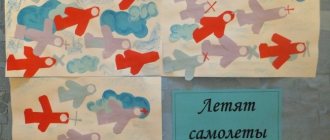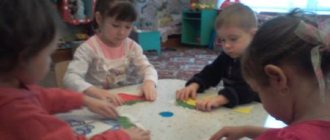Integrated lesson in the second junior group on traffic rules
Summary of an integrated lesson in kindergarten with children 3-4 years old “My friend traffic light”
Author: Efimova Alla Ivanovna, teacher of GBDOU No. 43, Kolpino St. Petersburg
Description: This material will be of interest to preschool teachers, teachers of after-school groups, and can be used by primary school teachers to conduct extra-curricular activities on this topic for primary school students. The summary is designed to familiarize children with road signs and their meaning. Purpose: To introduce some traffic signs. Objectives: - consolidate children’s knowledge about traffic lights and their signals; - develop the ability to answer questions in complete sentences.
Educator: Guys, today I suggest you go on a trip according to the rules of the road. Do you agree? Answers. Educator: Imagine, you need to go on a visit and you need to cross the road, and there are cars and buses driving there. For this you need to know the rules. Listen to the riddle and tell me the answer. I never sleep, I look at the road. I'll tell you when to stand, when to start moving. Children answer: Traffic light.
Educator: Correct. What colors are shown on the traffic light sign? Answers. Educator: What does each traffic light color mean? Answers. Educator: And now the second riddle is prepared for you: You can’t take this ribbon, And you can’t weave it into a pigtail. She lies on the ground, Transport runs along her. Children answer: Road. Educator: Tell me, can we walk along the road? Answers. Educator: Why can’t we walk on the roadway? Answers. Educator: Tell me the transport that you know? Answers. Educator: Who is driving, what is it called? Answers. Educator: And the people who travel on a bus, tram, minibus, what shall we call them in one word? Answers. Educator: I suggest you take a short break in the form of a physical minute.
The road is not a path, The road is not a ditch, First look to the left, Then look to the right. Turn to the left, smile at the friend next to you. Stomp your right foot, stomp your left foot, and go home boldly. Educator: Well done, they listened to the words carefully, performed all the movements correctly. Let's continue the conversation, listen carefully. Another mystery. A man is walking over me. He calls me a zebra. Children answer: Pedestrian crossing. Educator: What does a pedestrian crossing look like? Answers. Educator: To find out what another name is for a pedestrian crossing, listen to the following riddle. Under Seryozhka's feet there is a striped path. He walks along it boldly, and all the people follow him. Children answer: Zebra.
Educator: They answered well, you know the rules, I suggest you play a little and collect a sign. And we need to assemble a traffic light. Do we remember what colors are on a traffic light sign? Answers. Educator: What shape are they? Answers. Educator: In what order are they located? Answers. Educator: I invite you to the tables, and I suggest you assemble a road sign. Educator: It turned out to be a very beautiful sign. But in order to remember everything better and consolidate the knowledge gained, I also suggest you draw a traffic light sign. But for this, you need to stretch your fingers. Finger exercise: One, two, three, four, five. (Unclench your fingers from your fist one at a time, starting with the thumb.) The fingers went out for a walk. (Rhythmically unclench and squeeze all fingers together.) One, two, three, four, five. (We clench one by one, widely spaced fingers into a fist, starting with the little finger.) They hid in the house again. (We rhythmically squeeze all our fingers together.) Educator: Now, I’m absolutely sure that you will do great work. We sit down at our workstations and begin to do the work, or rather, draw a traffic light. Educator: Good work, you worked hard, you can relax.
Follow the road rules strictly, Don’t rush like you’re on fire, And remember: for transport - the road, And for pedestrians - the sidewalk! Yes, and parents are also instructed - After all, your children are looking at you. Always be a worthy example, and no trouble will happen on the road!
We recommend watching:
Integrated lesson in the younger group to familiarize children with the properties of ice. Scenario of entertainment on traffic rules in the younger group together with parents with a presentation. Program of a circle on traffic rules in the younger group of the preschool educational institution. Traffic light Fairy tale for children 3-4 years old according to traffic rules
Similar articles:
Summary of a lesson on traffic rules for young children in kindergarten
Lesson on traffic rules for children of the 2nd junior group. Competent pedestrian
Lesson notes on traffic rules in the 2nd junior group. Traveling around the city
Summary of a walk according to traffic rules in the younger group. Traffic light
Games on traffic rules for children 3-5 years old in kindergarten
Junior group. Early childhood, nursery. Children 1-4 years old
Photo report on the “Traffic Light” modeling lesson for young children
I would like to present to you my photo report on modeling with young children on the topic “ Traffic Light ”
. As part of introducing children to basic traffic rules. Children from an early age need to be introduced to traffic rules. This acquaintance takes place in different types of activities. These are movable...
Synopsis for a lesson on cognitive development “Traffic Light” for children of the early age group Synopsis “ Traffic Light ” on cognitive development. Goals: - Continue to introduce children to colors (red, yellow, green, the concepts of “big and small.” - Learn to distinguish and understand traffic light . - Develop memory, auditory perception Equipment: Toys: cars of different...
Principles of teaching traffic rules to middle group children
The goal of teaching traffic rules in a secondary preschool group is to repeat previously learned rules and master more complex tasks. At this stage, children are introduced to concepts such as car speed, road visibility, turning or reversing a car.
- The teacher creates an impromptu traffic situation. The child’s task is to analyze it and take the right actions. For this purpose, active games with toy cars are used, where the child is invited to comment on his actions, for example, a car is driving along the road, then speeds up, then slows down, reverses or turns.
- The child recites all the steps, the teacher corrects and gradually complicates the task. Classes in the middle group should be more conversational in nature - the teacher conducts conversations with children, involving them in discussions about the benefits of traffic rules and what could happen if people did not follow them. Children are given the task of writing a short story about a traffic light, cars and a pedestrian crossing or a bus and passengers.
- The teacher learns short poems or songs with the children, asks riddles on this topic, and solves crossword puzzles together. Role-playing games are also used in training - children are asked to feel like a driver or passenger. The teacher guides the child’s actions, commenting and suggesting the course of events, while pronouncing the necessary phrases.
With kids
During the training sessions, the teacher should highlight the main points:
- It is very dangerous to play near the roadway - a car moves faster than a person, so you should not cross the road in front of walking cars. The teacher explains that there are bicycle paths for cycling, sledding in winter should be as far away from the road as possible, the same applies to roller skating and skating. For these purposes, special park spaces or sites are equipped.
- You should be careful when walking around large vehicles that block the view of the roadway . You cannot run onto the road without making sure that the roadway is clear. Before crossing the road you need to look both ways.
- It is necessary to cross the road in a strictly designated place - at a pedestrian crossing. You can start moving across the road only after the cars have stopped to allow pedestrians to pass. When a car honks, you should not rush around. It is necessary to stop moving; it is much easier for the car to go around an immovable object.
- At public transport stops, you should not be too close to the roadway while waiting for the bus. You should approach the vehicle when it has finished moving and opened the doors for entry.
- It is also important to study the topic of rules for passengers - the basic requirements for precautionary measures when exiting and entering public transport . You can exit only when you stop completely and look around. It is also necessary to touch upon the topic of behavior inside a moving vehicle - you cannot run around the inside of the bus while driving, distracting the driver. The teacher should tell the children about safety measures in case of an emergency.
- You should walk along the road on the sidewalk on the right side so as not to disturb oncoming passers-by. If the area is outside the city, then you need to follow along the side of the road facing the traffic.
- Pay attention to traffic lights - cross the road only when the light is green.
For kindergarten
It is necessary to involve parents in the process of teaching children traffic rules - the teacher gives home assignments in which parents can directly participate. For example, make a craft or applique at home from available materials, draw a picture on the topic of traffic rules, learn a short poem or song on a given topic. First, the teacher conducts a consultation conversation with parents - tells them how to conduct joint classes correctly, how the dialogue between an adult and a child should be structured, what questions to ask and what to pay attention to.
Home-based classes allow preschoolers to further strengthen the material they have learned. Repetition can also be done while walking around the city - the child sees the road and all types of transport in real life, learns to interact with them, comments on the current situation, draws conclusions from it, and makes decisions. It is important for the parent to direct the child’s conclusions to the correct results and actions, based on the general principles of the rules of pedestrian behavior on the roadway.
MAGAZINE Preschooler.RF
Lesson notes on traffic rules in the second junior group. “Everyone should know the rules of the road”Teacher Gnezdilova Maria Sergeevna
Description of material:
I offer you a summary of direct educational activities on the topic “Everyone should know the rules of the road” for children 3-4 years old; this material will be useful for preschool teachers of the second junior group. This educational activity is aimed at strengthening children's understanding of traffic rules.
Equipment and materials: two dolls, images of road signs, TV, educational game “Sparrows and Cars” .
Goals:
- Give children knowledge about where and how to cross the street, familiarize them with special signs - pedestrian crossing signs, and introduce the word “crossing” .
- To acquaint children with the rules of safe behavior on the roads, develop cognitive abilities, speech, expand spatial orientation, get children to answer questions, arouse interest in learning traffic rules
- Explain to children that they need to go out only with adults, to cultivate in children such qualities as kindness, attentiveness, responsiveness, independence, curiosity
Progress of the lesson:
Educator: Hello, children! Oh, someone is knocking on our door, let's see who it is. (The teacher brings in the dolls Masha and Katya.) Guys, the dolls Masha and Katya came to visit us. When they came to visit us, they almost got into trouble on the road. They are still small and do not know at all how to cross the road correctly and where to cross it. Shall we show and tell our dolls where to cross the road? Children (in chorus): Yes!
Educator: Is the road needed for cars?
Children: Yes.
Educator: That's right, cars are driving along the road. Tell me, is it possible to play on the road and cross it wherever you want?
Children: No!
B. Correct. Let's remember what they call people walking down the street?
D. Pedestrians.
V. Well done! Tell me, should pedestrians obey traffic rules?
D. Yes.
V. Of course! And we teach you these rules. And we must cross the roadway in specially designated places and where the “Pedestrian Crossing” sign is installed. It is installed at the crossing point of the roadway, next to the pedestrian crossing markings, such markings are called “zebra crossings”.
This sign is not complicated at all,
But so reliable
He helps along the way
We need to cross the road.
D. This sign is called “Pedestrian Crossing.”
Q. Let's repeat once again, how do pedestrians walk?
(with a calm step, along ... the sidewalk, on the right side, so as not to disturb other pedestrians who are walking towards you. But we need to cross to the other side. What should we do?)
D. Cross the road at the pedestrian crossing.
B. Correct. You must cross the road in a specially designated place and only when the traffic light is green. What is another name for a “pedestrian crossing” ?
D. Zebra.
Q. Why?
D. Because the zebra also has black and white stripes.
Educator: Yes, that's right! But I know that Masha and Katya were in a hurry to visit us and ran across the road in the wrong place. Is it possible to do this?
Children: No!
Educator: Remember, Masha and Katya, and you guys: walking across the road not at a pedestrian crossing is dangerous for life!
Physical school
We're going, we're going home in a passenger car. (movements simulating turning the steering wheel) We drove up the hill: bang! (hands up, clap above head) The tire is flat: stop. (arms down to sides, sit down)
Educator: What great fellows you are! Now guys, let's watch a cartoon about the rules of behavior on the road.
Children: Let's go!
Educator: Well done! Let's repeat it to Masha and Katya again: where should you cross the road?
Children: Along the pedestrian crossing.
The teacher invites the children to play the game “Sparrows and Cars” . The game is repeated at the request of the children 2-3 times.
The teacher asks the children questions to consolidate their acquired knowledge: So, can children play on the road? (No). That's right, well done, we can't play on the road because it's dangerous for our lives. Now tell me where to cross the road? (On the pedestrian crossing). Absolutely right, we cross the road only in specially designated areas for pedestrians. Is it possible to cross the road in the wrong place? (No). Well done, this is dangerous for our lives and is a violation of traffic rules. Now the guys and I are sure that you Masha and Katya will not break traffic rules and will be competent pedestrians, like the guys and I. Thank you bye.
| Next > |



